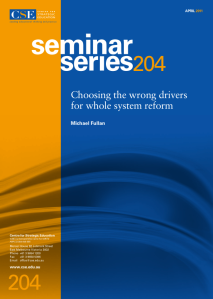 Interesting how, once you see a reference to an idea, it pops up everywhere. And although this work from Michael Fullan came out last year, it’s slid across my radar twice this week.
Interesting how, once you see a reference to an idea, it pops up everywhere. And although this work from Michael Fullan came out last year, it’s slid across my radar twice this week.
Fullan’s paper – Choosing the wrong drivers for whole system reform (April, 2011) – highlights that policy makers who select the wrong drivers (like testing, accountability, fragmentation – and technology) may get a few runs on the board, but they won’t achieve system lift.
He picks out the following as the right drivers that, when working in tandem, show evidence of making a systemic difference. Efforts to lift schooling must:
- foster intrinsic motivation for teachers and leaders
- engage students and teachers in continuous improvement of instruction and learning
- inspire collective or team work
- affect all teachers and leaders
A key point he makes, for me, is around technology: That the mistake is thinking that a new and shiny technology will somehow make the difference – but “not without smart pedagogy it won’t”.
He argues firmly for pedagogy, not technology, to be in the driving seat, no matter how seductive those shiny things might be. Once teachers are grounded in effective instruction, that integrates technology, then we might see acceleration in engagement.
“Without pedagogy in the driving seat, there is a growing evidence that technology is better at driving us to distraction , and that the digital world of the child is detached from the world of the school” (p. 15)
He cites OECD surveys that suggest that deep learning with technology rarely happens at home, so schools need to be the place where that depth of engagement and higher order thinking occurs.
Possibly this is nothing new – but it’s good to hear it from Fullan, and in a way that positions the thinking at a policy level.

Thanks for this post Karen, this really speaks to me, especially as I’m working with a school at the moment who are coping/dealing with their student’s misuse of Facebook (primary school). In this context, there is a real need to inform the community, as well as a update/modify the school’s cybersafe policy and user agreements.
Apart from the intrinsic motivation – that the inappropriate behaviours online (at home and school) stop, there is also a real need for all teachers and leaders (as well as the wider community) to come together as a collective to collaboratively construct the policy and strategies needed to address these issues 24/7.
What speaks to me the most in this scenario, is the need for everyone to be informed and aware of what is the most appropriate, effective use of technologies (e-learning pedagogy) – not just for engagement and thinking, but for the safety and well-being of the students.
LikeLike
Thanks for your comments, Tessa. Your example touches on that important need to have everyone involved, in ways that mean something to each of them. Fullan makes a nice comment about the importance of talking about improving ‘instruction’, rather than improving the ‘teacher’ – it’s a useful way to think about how we should try to depersonalise problems of practice into something beyond ourselves for critique and exploration – how might cybersafety be part of that pedagogical conversation? Good luck with the challenge in your school! Keep me posted. Cheers, Karen:-)
LikeLike
Great post Karen. Technology is a tool, not a transformer. Teachers are transformers.
LikeLike
Thanks for stopping by, Mark. Couldn’t agree more (and that Papert quote keeps springing to mind:-).
LikeLike
Love it, Karen – this message resonates with me. If we focus on the pedagogy we’ll make much better use of the technology to engage learners and increase achievement. Couldn’t agree more with the comment about schools needing to be the place where depth of engagement and higher order thinking occurs.
LikeLike
You are of course so right. Karen. Unless we as schools / teachers know what we are doing with the shiny technology to improve our work in relationship to how our students learn then it is a waste of time and effort.
A little shiny does however attract some students. I have been working to have maths students record their learning on video. When I brought out the GoPro video camera all the reluctant males instantly wanted to record!
Cheers.
LikeLike
Thanks so much for your comments, Anne and Barry. Glad the post has been a useful read – Fullan always talks good sense:-) Anne, I’m always on the look out for the way tech is effectively combined with activities that scaffold deep learning – I see Pam Hook is keeping a list of people blogging about how they use SOLO: http://www.diigo.com/list/artichoke/solo-taxonomy-blogs
And I know what you mean, Barry, I am a sucker for the shiny gadget and I think that’s ok. It’s just what happens next that matters!;-)
LikeLike